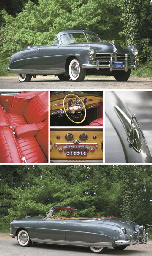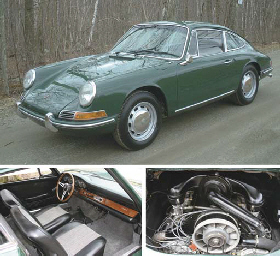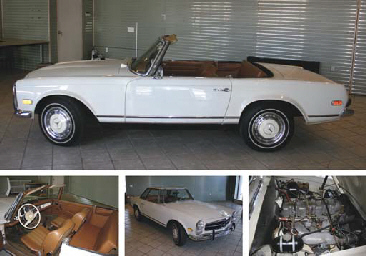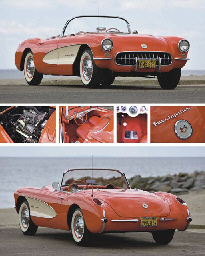c1914 STUTZ MODEL 4E BEARCAT (REPRODUCTION)
c1914 STUTZ MODEL 4E BEARCAT (REPRODUCTION) Chassis No. 1337 Red with black leather interior Engine: four cylinder, in-line, T-head, 390 ci., 50 hp; Gearbox: three speed manual; Suspension: semi-elliptic leaf springs, front and rear; Brakes: mechanical, internal expanding. Right hand drive. The Stutz Bearcat. One of the most evocative names and most desirable American automobiles ever made. Many manufacturers have looked to competition as a way to market their cars for the road, especially in the early years of the automobile when every journey could be a challenge and performance and reliability were as important as specification, appearance and price in a motorist's purchase decision. Arguably none could claim more quickly a reputation for competition success than Stutz, "The Car That Made Good in a Day". Harry C. Stutz founded the Ideal Motor Company in Indianapolis, Indiana in 1911. That same year he entered his brand-new eponymous named car in the inaugural Indianapolis 500 mile race at the Indianapolis Motor Speedway. The untested auto achieved a credible 11th place finish on its first outing, indeed making it quite good "in a day". Stutz built on that achievement by launching the Bearcat, its most famous car. Little more than a racing chassis with two seats, fuel tank and fenders, it made a nod to practicality with a rear-mounted trunk and a monocle-style windshield to help shield the driver from the wind. It was truly one of the first "sports cars", as ready for the track as it was for the road and a status symbol for the rich, glamorous and famous of the era. "Bearcat" was also a most appropriate name for the car, conjuring in the mind a combination of power and grace. With its potent engine and proprietary three speed transaxle, along with the deep, ripping sound of the exhaust, immediately made every journey feel like a championship race. Early in 1915, a Bearcat was driven from California to New York in record breaking time. With the only modification the removal of the fenders, E. G. "Cannonball" Baker drove the trip alone in 11 days, 7 hours and 15 minutes and in the process smashed every standing cross country record. The integrity of the Bearcat's build quality was proven in that the only failure (besides tires) was a single shock absorber- and this in the days when much of the journey would have been made on roads little better than horse trails. By the end of 1915, continuing its success on the track, Stutz was the racing champion of the United States. As was the case with many of the pioneering manufacturers, Stutz began to stumble in the early twenties. Founder Harry Stutz left the management of the company and although many engineering advances were made and successes on the racetrack were had into the early thirties, by the middle of the decade Stutz was forced to end production. The superb reputation of Stutz rests on less than 36,000 cars built from 1911 through 1935. With the iconic stature of the Stutz Bearcat, its no wonder that, from the time when automobiles began to be regarded as collector's items that it has featured prominently on the wish list of the most knowledgeable enthusiasts. That popularity has resulted in ever higher values for one of the original Bearcat models built between 1912 and 1916. Mr. Samuel Flohr of Colorado was a noted collector who first joined the AACA in the early seventies. Focusing on brass era cars, he won no fewer than five AACA Cups from 1984 through 1990 for his cars, including a 1906 Buick, 1906 Stanley, 1904 Pope-Toledo and a 1904 Olds. He also drove the Olds in the 1985 London-to-Brighton Run and enthusiastically drove many of his cars on tours. In the 1980s, Mr. Flohr commissioned noted Stutz owner, restorer and expert Paul Freehill of Ft Wayne, Indiana, to build a recreation of this legendary car. More actually a replica in the proper sense of the word, Mr. Freehill started with an accurate reproduction frame and used many original parts as well as corr
c1914 STUTZ MODEL 4E BEARCAT (REPRODUCTION)
c1914 STUTZ MODEL 4E BEARCAT (REPRODUCTION) Chassis No. 1337 Red with black leather interior Engine: four cylinder, in-line, T-head, 390 ci., 50 hp; Gearbox: three speed manual; Suspension: semi-elliptic leaf springs, front and rear; Brakes: mechanical, internal expanding. Right hand drive. The Stutz Bearcat. One of the most evocative names and most desirable American automobiles ever made. Many manufacturers have looked to competition as a way to market their cars for the road, especially in the early years of the automobile when every journey could be a challenge and performance and reliability were as important as specification, appearance and price in a motorist's purchase decision. Arguably none could claim more quickly a reputation for competition success than Stutz, "The Car That Made Good in a Day". Harry C. Stutz founded the Ideal Motor Company in Indianapolis, Indiana in 1911. That same year he entered his brand-new eponymous named car in the inaugural Indianapolis 500 mile race at the Indianapolis Motor Speedway. The untested auto achieved a credible 11th place finish on its first outing, indeed making it quite good "in a day". Stutz built on that achievement by launching the Bearcat, its most famous car. Little more than a racing chassis with two seats, fuel tank and fenders, it made a nod to practicality with a rear-mounted trunk and a monocle-style windshield to help shield the driver from the wind. It was truly one of the first "sports cars", as ready for the track as it was for the road and a status symbol for the rich, glamorous and famous of the era. "Bearcat" was also a most appropriate name for the car, conjuring in the mind a combination of power and grace. With its potent engine and proprietary three speed transaxle, along with the deep, ripping sound of the exhaust, immediately made every journey feel like a championship race. Early in 1915, a Bearcat was driven from California to New York in record breaking time. With the only modification the removal of the fenders, E. G. "Cannonball" Baker drove the trip alone in 11 days, 7 hours and 15 minutes and in the process smashed every standing cross country record. The integrity of the Bearcat's build quality was proven in that the only failure (besides tires) was a single shock absorber- and this in the days when much of the journey would have been made on roads little better than horse trails. By the end of 1915, continuing its success on the track, Stutz was the racing champion of the United States. As was the case with many of the pioneering manufacturers, Stutz began to stumble in the early twenties. Founder Harry Stutz left the management of the company and although many engineering advances were made and successes on the racetrack were had into the early thirties, by the middle of the decade Stutz was forced to end production. The superb reputation of Stutz rests on less than 36,000 cars built from 1911 through 1935. With the iconic stature of the Stutz Bearcat, its no wonder that, from the time when automobiles began to be regarded as collector's items that it has featured prominently on the wish list of the most knowledgeable enthusiasts. That popularity has resulted in ever higher values for one of the original Bearcat models built between 1912 and 1916. Mr. Samuel Flohr of Colorado was a noted collector who first joined the AACA in the early seventies. Focusing on brass era cars, he won no fewer than five AACA Cups from 1984 through 1990 for his cars, including a 1906 Buick, 1906 Stanley, 1904 Pope-Toledo and a 1904 Olds. He also drove the Olds in the 1985 London-to-Brighton Run and enthusiastically drove many of his cars on tours. In the 1980s, Mr. Flohr commissioned noted Stutz owner, restorer and expert Paul Freehill of Ft Wayne, Indiana, to build a recreation of this legendary car. More actually a replica in the proper sense of the word, Mr. Freehill started with an accurate reproduction frame and used many original parts as well as corr















Try LotSearch and its premium features for 7 days - without any costs!
Be notified automatically about new items in upcoming auctions.
Create an alert